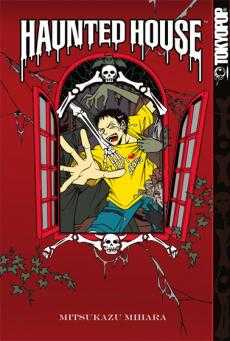Haunted House (manga)
| Haunted House | |
 The English-language cover as published by Tokyopop | |
| Genre | Horror, Comedy |
|---|---|
| Manga | |
| Written by | Mitsukazu Mihara |
| Published by | Shodensha |
| English publisher |
|
| Published | October 8, 2002 |
| Volumes | 1 |
Haunted House (ホーンテッドハウス) is a comedy horror manga written and illustrated by Mitsukazu Mihara. Known for her short stories and characters dressed in the Gothic Lolita fashion,[1] Mihara continued her use of death-themed material in Haunted House, a volume of one-shot chapters focusing on the teenage protagonist's attempts to find and keep a girlfriend despite his gothic family. Shodensha published Haunted House in Japan on October 8, 2002.
Tokyopop licensed it for an English-language release in North America, along with four of her other works, and released it on October 10, 2006. English-language critics were divided on whether it was enjoyable or repetitive, with several comparing it to the Addams Family.
Plot
Haunted House consists of one-shot chapters connected by the teenage protagonist, Sabato Obiga—his first name refers to Sabbath.[2] In each, he attempts to find and keep a girlfriend, whom his gothic family inevitably frightens away.[3] His family is made up of his father, who works at a bank; his mother, a reader of poetry; twin sisters Lisa and Misa, both of whom create voodoo dolls; and their black cat.[2][3][4] In Haunted House, Mitsukazu Mihara continued her use of death-themed material—also seen in her other manga The Embalmer and R.I.P.: Requiem in Phonybrian.[2]
Release
Written and illustrated by Mitsukazu Mihara, Haunted House was published in Japan by Shodensha on October 8, 2002 (ISBN 4396762887).[5] Tokyopop licensed it for an English-language release in North America—along with four of her other works: The Embalmer, Beautiful People, IC in a Sunflower and R.I.P.: Requiem in Phonybrian[6]—and released it on October 10, 2006 (ISBN 978-1-59816-321-6).[7]
Reception
Critical reaction to Haunted House was mixed. Critics drew comparisons between the manga and the Addams Family.[2][4][8] The Comic Book Bin's Leroy Douresseaux felt that her elaborate art partially helped to counterbalance the morbid material, and rated the manga 5/10.[2] While enjoying the occasional "cute and mildly amusing moments", Ryan Huston of MangaLife felt that the gothic stock elements, repetitive plot and "lackluster" art hurt the volume.[4] Conversely, Katherine Dacey praised the "elegant, stylized character designs" and enjoyable story, though she commented that the "moral is delivered a little too neatly".[8] Another reviewer greatly enjoyed the comedy aspect of Haunted House, though wrote that "it was an acquired taste".[3]
References
- ↑ "Manga+Comics: Mitsukazu Mihara: Haunted House". Tokyopop. Archived from the original on November 16, 2007. Retrieved October 21, 2011. "Famous for the "Gothic Lolita" fashions that she dresses her characters in, Mihara-sensei is considered a master of the short story."
- ↑ 2.0 2.1 2.2 2.3 2.4 Douresseaux, Leroy (October 30, 2006). "Haunted House". The Comic Book Bin. Retrieved October 19, 2010.
- ↑ 3.0 3.1 3.2 Connie (October 4, 2009). "Haunted House". Slightly Biased Manga. Retrieved October 19, 2010.
- ↑ 4.0 4.1 4.2 Huston, Ryan. "Haunted House Review". MangaLife. Archived from the original on October 14, 2007. Retrieved October 19, 2010.
- ↑ "Haunted House" (in Japanese). Shodensha. Retrieved October 19, 2010.
- ↑ "Mitsukazu Mihara Titles Confirmed at Tokyopop". Anime News Network. July 26, 2005. Retrieved October 19, 2010.
- ↑ "Amazon.com: Mitsukazu Mihara: Haunted House". Amazon.com. Retrieved October 19, 2010.
- ↑ 8.0 8.1 Dacey, Katherine (October 29, 2009). "Short Takes: Haunted House, Mermaid Saga, and School Zone". The Manga Critic. Retrieved October 19, 2010.
External links
- Haunted House at Tokyopop's website
- Haunted House (manga) at Anime News Network's Encyclopedia
| ||||||||